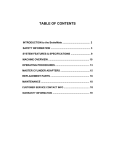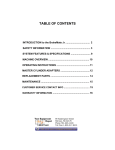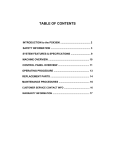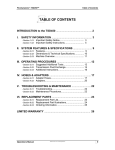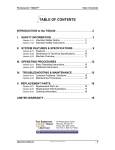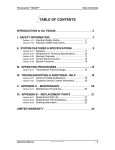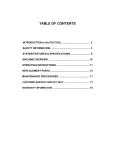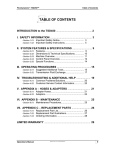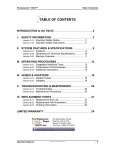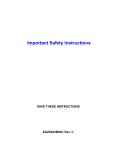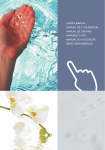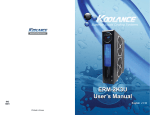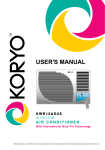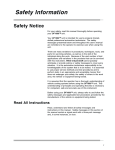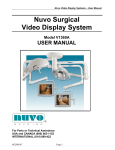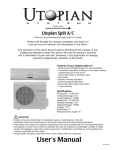Download BrakeMate - Flo
Transcript
TABLE OF CONTENTS INTRODUCTION to the BrakeMate ........................................ 2 SAFETY INFORMATION .......................................................... 3 SYSTEM FEATURES & SPECIFICATIONS ............................. 9 MACHINE OVERVIEW ............................................................ 10 OPERATING PROCEDURES .................................................. 13 MASTER CYLINDER ADAPTERS ........................................... 15 REPLACEMENT PARTS ......................................................... 16 MAINTENANCE ....................................................................... 18 CUSTOMER SERVICE CONTACT INFO ........................................ 18 WARRANTY INFORMATION ...................................................... 19 INTRODUCTION to the BrakeMate Congratulations on the purchase of your BrakeMate brake flush machine! The BrakeMate is a fully automatic brake-flushing machine that can service all 4 wheels in under 9 minutes. Brake service is now more profitable, since we have eliminated the need for a second technician when performing a brake bleeding service. The BrakeMate provides the shop with the ability to flush and pressure test a brake system faster and easier than ever before with a combination of automation, speed and effectiveness. The Brakemate also follows the OE recommended flushing sequence. Please take time to read through this manual to familiarize yourself with the BrakeMate before performing your first brake flush. 2 IMPORTANT SAFETY NOTICE For your safety, read this manual thoroughly before operating this machine. Your BrakeMate unit is intended for use by properly trained, skilled professional automotive technicians. The safety messages presented below and throughout this user’s manual are reminders to the operator to exercise care when using this unit. Before using your BrakeMate unit, always refer to and follow the safety messages and applicable service procedures provided by the manufacturer of the vehicle being serviced. • Read All Safety Instructions Read, understand and follow all safety messages and instructions in this manual. Safety messages in this section of the manual contain a signal word with a three-part message and, in some instances, an icon. • Signal Words The signal word indicates the level of the hazard in a situation: Indicates an imminently hazardous situation which, if not avoided, will result in death or serious injury to the operator or to bystanders. Indicates a potentially hazardous situation which, if not avoided, could result in death or serious injury to the operator or to bystanders. Indicates a potentially hazardous situation which, if not avoided, may result in moderate or minor injury to the operator or to bystanders. Indicates a situation which, if not avoided, may result in damage to the machine, or the vehicle being serviced. • Safety Messages Safety messages in this section contain three different type styles: • Normal type states the hazard. • Bold type states how to avoid the hazard. • Italic type states the possible consequences of not avoiding the hazard. 3 • Safety Symbols A safety symbol, when present, gives a graphical description of the potential hazard, and how to avoid the hazard: 4 Risk of Fire Read Instructions Before Use Risk of Explosion Mandatory Eye Protection Risk of Entanglement Mandatory Protective Gloves Dangerous Fumes Mandatory Protective Clothing Do Not Pull or Move Risk of Burns IMPORTANT SAFETY INSTRUCTIONS Engine exhaust contains toxic gases. • Vent vehicle’s exhaust away from work area. • Do not breathe exhaust. Exhaust gases will cause injury or death. Improper use and operation. • Read, understand and follow all safety messages and operational procedures in this manual before operating this machine. • This equipment should be operated only by qualified personnel. • Use this equipment only as described in this manual. Improper use and operation of this product can result in injury. Engine systems can malfunction expelling fuel, oil vapors, hot steam, hot toxic exhaust gases and other flying particles. • Wear safety goggles and protective clothing, user and bystander. Everyday eyeglasses only have impact resistant lenses, they are NOT safety glasses. • Do not position head directly over or in front of carburetor or throttle body. Engine backfire can occur when air cleaner is out of normal position. • Make sure gauge reads zero before connecting or disconnecting hose connections to adapters. • Make sure cooling system pressure has been relieved before connecting or disconnecting hose connections and adapters. • Keep a dry chemical (Class B) fire extinguisher rated for gasoline, chemical & electric fires in the work area. Fire, explosion, or flying particles may cause serious injury. Risk of expelling pressurized fluids. • Wear safety goggles and protective clothing, user and bystander. 5 • Engine systems can malfunction, expelling fuel, oil vapors, hot steam, hot toxic exhaust gases and other debris. • Always unplug the machine from its power source when not in use. • Keep the service hoses away from hot or moving engine parts. Hoses can split or burst causing fluid to be expelled. • Avoid contact with brake fluid. • Treatment methods are as follows: Eyes: Flush eyes with plenty of water. Skin: Wash with soap and water. Inhalation: Move to uncontaminated area. Ingestion: If large amount, get medical attention. If any irritation persists, get medical attention. • Dispose of used fluid according to environmental laws and regulations. Fuel, oil vapors, hot steam, hot toxic exhaust gases, pressurized fluid, and other debris can cause serious injury. Risk of unexpected vehicle movement. • Block drive wheels before starting vehicle’s engine to begin an exchange. • Unless instructed otherwise, set parking brake and put gear selector in park. • Do not leave a running vehicle unattended. • If vehicle has an automatic parking brake release, disconnect release mechanism for testing and reconnect when testing is completed. A moving vehicle can cause injury. Risk of entanglement. Engine has moving parts. • Do not place tools on fenders or other places in engine compartment. • Keep yourself, clothing, battery cables and service hoses clear of moving parts such as fan blades, belts, pulleys, hood and doors. • Barriers are recommended to help identify danger zones in test area. • Prevent personnel from walking through immediate test area. Contact with moving parts can cause injury. Risk of fire or explosion. • Do not operate in the vicinity of open containers of flammable liquids such as gasoline. • Keep hoses and jumper cables away from heat sources and sharp edges. • Do not operate equipment with damaged cords or hoses until they have been examined by a qualified serviceman. Fire or explosion can cause injury. 6 Risk of fire or explosion. Gases produced by a battery are highly explosive. • Wear safety goggles and protective clothing, user and bystander. • This machine is equipped to operate on 12-volt DC power only. A power source greater than this can result in serious injury to the user as well as damage to the machine. • Do not smoke, place metal tools on battery or allow a spark or flame in vicinity of battery. • Clean battery terminals before hooking the machine’s battery clips to them. During cleaning, keep airborne corrosion from eyes, nose and mouth. • Be sure both battery cables are tightly connected to the battery terminals as instructed before proceeding with a fluid exchange. • Never remove battery cables from the battery terminals while the machine is operating. Battery explosion can cause injury. Risk of burns. • Wear gloves when handling hot engine components. • Do not touch hot exhaust systems, manifolds, engines, radiators, etc. Hot engine parts may cause injury. Battery acid is a highly corrosive sulfuric acid. • Wear safety goggles and protective gloves, user and bystander. • Have plenty of fresh water and soap nearby. If battery acid contacts skin, clothing, or eyes, flush exposed area with soap and water for 10 minutes. • While cleaning battery’s terminals, keep airborne corrosion from eyes, nose and mouth. • Do not touch eyes while working near battery. Battery acid can burn eyes and skin. Risk of burns. • Wear gloves when working near hot engine components. • Do not touch hot exhaust systems, manifolds, engines, radiators, etc. • The fluid coming from the vehicle along with some of the machine’s components that the fluid comes into direct contact with (i.e. hoses and fittings) may reach temperatures uncomfortable to the touch. Exercise caution in avoiding contact with these items. Hot components can cause injury or discomfort. 7 Risk of injury. • This equipment should be operated by qualified personnel only. • Use this equipment only as described in this manual. • Always unplug the machine from its power source when not in use. • Loop the power cord loosely in its proper location when machine is not in use. • Do not operate equipment with a damaged battery cables or hoses, or if the equipment has been dropped or damaged, until it has been examined by a qualified service representative. • Care should be taken to arrange the battery cables and service hoses so that they will not be tripped over or pulled. • Never pull on the power cables or service hoses to transport the machine. Damage may occur to these components, or machine may tip over. • Keep area of operation clear of unnecessary tools and equipment. Utilize recessed tool storage areas on the top of the machine. • Never leave the machine running unattended. • The BrakeMate is not designed for any other purpose than the servicing of automotive brake systems. Operation of this machine by anyone other than qualified personnel may result in injury. Misdiagnosis may lead to incorrect or improper repair and/or adjustment. • Do not rely on erratic, questionable, or obviously erroneous test information or results. If test information or results are erratic, questionable, or obviously erroneous, make sure that all connections and data entry information are correct and that the test procedure was performed correctly. If test information or results are still suspicious, do not use them for diagnosis. Improper repair and/or adjustment may cause vehicle or equipment damage or unsafe operation. Risk of equipment damage. • Connect battery cables to a 12-volt power source only (i.e. vehicle’s battery). • Servicing, transporting, or storing this machine in an attitude other than the normal operating position can result in fluid spillage and/or component damage. • Never pull on the power cables or service hoses to transport the unit. Damage may occur to these components, or machine may tip over. Always use the handle to move. • Periodically clean the machine by wiping down with a clean, soft, dry cloth. Improper operation of equipment may result in damage to machine or components. SAVE AND FOLLOW THESE INSTRUCTIONS! 8 DIMENSIONS & TECHNICAL SPECIFICATIONS DIMENSIONS: 39" Tall 17" Wide 31" Deep Service Hose: 15’ outside of machine Wheels: 5” locking casters (front) 5” casters (back) Fluid Tanks: 7-Quart New Fluid Tanks 20-Quart Waste Fluid Tank Weight: 70 lbs TECHNICAL SPECIFICATIONS: Power: 12-Volt DC from vehicle battery Fuse: 15 Amp Operating Temperature: 60º to 110ºF (15º to 43ºC) FEATURES • Durable roto-cast polyethylene body and tanks prevent vehicle damage • Ergonomically correct working height • 5” caster wheels allow easy maneuverability • Clear sight tubes allow visual confirmation of new and waste fluid movement • Easy access service panel 9 10 MACHINE OVERVIEW 11 CONTROL PANEL OVERVIEW BUTTONS Button: Function: M/C PRESSURE Pressurizes the master cylinder. ABS Toggles ABS function on and off. ENTER/ START Enter sequence wheel choice/start exchange. SELECT Selects wheel sequence for exchange. ADD FLUID/ DRAIN NEW TANK Pumps new fluid out of service hose. REMOVE FLUID 1 Press- Pulls fluid through ABS line. Press and Hold - Pulls fluid through all 5 lines. DRAIN WASTE TANK Drains waste tank through service. PRIME Purges air out of service hose after machine is completely emptied of fluid. STOP Stops operations. 12 LED Lights Light: Indication: ABS ABS mode is turned on. WASTE TANK FULL The waste fluid tank needs to be drained. NEW TANK EMPTY There is no more new fluid in the machine. RUNNING The brake flush is in progress. STATUS LIGHT Steady - Machine has power. Flashing - Current process is complete. 13 OPERATING PROCEDURES NOTE: If machine will not prime or drain, remove service panel and locate solenoid valve (labeled #1). Loosen hose fitting until a small amount of fluid drips out. Tighten and reattempt prime or drain. MACHINE SETUP: 1. 2. 3. 4. 5. 6. 7. 8. Fill New Fluid Tank with fresh brake fluid. Connect the machine’s battery cables to the vehicle’s battery. When the machine powers up you will notice the light on the front of the machine always stays lit telling you you’re connected to power. With all hoses on resting ports press the “PRIME” button. Let machine run until you see fluid in the yellow Tygon lines. Press “STOP” button. Close ball-valve on service hose. Hold “REMOVE FLUID” button down until all lights come on. This will relieve pressure on the red manifold after priming. DRAIN THE MASTER CYLINDER: 1. 2. 3. Remove ABS yellow Tygon line from holder and attach suction hose. Remove the master cylinder cover and insert suction hose, then press the “REMOVE FLUID” button on the control panel. NOTE: Leave a small amount of fluid in the bottom of the reservoir to make sure no air is introduced into the system. Press the “STOP” button when finished removing fluid. CONNECT TO THE MASTER CYLINDER: 1. 2. 3. Find and attach correct master cylinder adapter from adapter kit. Attach yellow hose to master cylinder adapter and make sure the ball valve is in the open position. Press the “M/C PRESSURE” button and verify that there are no leaks around the master cylinder cap. This button will pressurize the brake system so you can safely open the bleeder screws preventing air from entering the bleeder. NOTE: Make sure the pressure hose is not putting any torque on the master cylinder adapter, which may cause leakage. CONNECT TO THE BLEEDER VALVES: 1. 2. 3. 4. 5. 14 Raise the vehicle. Verify that all bleeder screws can be opened before attaching Tygon lines. Attach Tygon lines to respective bleeder fittings. Open bleeder screws about 1/4 turn until fluid begins to flow into the yellow lines. NOTE: Make sure the bleeder stays open after you remove the wrench. If desired and the vehicle is equipped, the ABS line can be connected to the bleeder screw on the ABS unit in the engine bay and the ABS function can be toggled on in order to flush the ABS unit (this step is not required to perform a flush). BEGIN THE FLUSHING PROCESS: 1. The lights on the board depicting the wheels of the car will flash from one to the next when no sequence is selected. 2. Select a sequence by touching the “Select” button until the wheel you want to service first is illuminated; then touch the “Enter/Start” button. 3. Repeat until all wheels have been selected. 4. Touch the “Enter/Start” button again after all wheels have been selected to start the flush. DISCONNECT: 1. 2. 3. 4. 5. 6. Close all bleeder valves on vehicle. Return to machine and hold “Remove Fluid” button down until vacuum pump begins to run and all four wheel lights illuminate on control panel. Remove all yellow Tygon lines from bleeder fittings Lower the vehicle. Close ball valve on pressure line and carefully remove from adapter using rag. Remove master cylinder adapter and verify fluid level in reservoir. ADJUST FLUID LEVEL: TOP OFF: 1. Connect open end hose to yellow service hose and press “ADD FLUID” button. 2. Slowly open ball valve until fluid reaches the correct level. 3. Replace the master cylinder cover. REMOVE FLUID: 1. Remove ABS line from holder and attach suction hose. 2. Remove the master cylinder cover and insert suction hose, then press the “REMOVE FLUID” button on the control panel. 3. Press the “STOP” button when finished removing fluid. 4. Replace the master cylinder cover. TEST: 1. Start vehicle and check brake pedal to ensure solid feeling. DRAIN THE WASTE FLUID TANK: 1. 2. 3. 4. Connect the machine’s battery cables to a 12V power source. Connect open-end hose to black service hose and insert into appropriate disposal container. Open the ball valve. Press “DRAIN WASTE TANK” button on the control panel. WARNING! Brake fluid is highly corrosive, and will damage surfaces if not cleaned up promptly. Always check for brake fluid under the machine before storing, especially under the back of the machine where new fluid is filled. Any spills should be cleaned up immediately. 15 16 17 REPLACEMENT PARTS LIST Part # 941587W 941504W 941556 941502 941503 941545 R941251 941506 941546W 941416 941510 941512 941535 941500 941533 941509 941540 941288 941524 18 Description Control Panel w/ Electronic Board & Label Complete Manifold Assembly Sight Glass Tube Pressure Side Pump Waste Tank Drain Pump Vacuum Side Pump Level Switch Pressure Switch Battery Cable Assembly Master Cylinder Adapter Kit Service Hose w/ Ball Valve Yellow Tygon Line 1/8" Hose Barb for Tygon Lines Bleeder Nipple Adapter Quick Disconnect Fitting for Bleeder Nipple Adapter Internal Hose Kit Yellow Service Hose Wand Adapter (Waste Fluid) Wand Adapter (New Fluid) R940750 R940751 942113 941520 941252 941508 P941530 941261 Chassis Console Tank Cap New Fluid Tank (White) Used Fluid Tank (Red) Service Panel Label Shepherd's Hook Vinyl Mat R942118 R942137 Locking Caster Wheel Caster Wheel 941522 941523-O Operations Manual Quick Start Instruction Sheet To order replacement parts for the BrakeMate, call: 1-800-303-5874 19 MAINTENANCE To keep your machine working properly… • Keep debris out of new fluid. • Avoid spilling fluid on the control panel. • Periodically wipe down exterior using a soft, damp cloth. CUSTOMER SERVICE CONTACT INFORMATION If you are experiencing problems with this machine, call technical support at: 1-800-303-5874 20 LIMITED ONE (1) YEAR WARRANTY Flo-Dynamics warrants only to the original Purchaser that under normal use, care and service, the Equipment (except as otherwise provided herein) shall be free from defects in material and workmanship for one year from the date of original invoice. External hoses, remote control modules, adapters and all other attachments, supplies and consumables (except as otherwise provided herein) are warranted for 90 calendar days from the date of original invoice. Filter elements are not warranted. Printed circuit boards purchased from, but not installed by Seller are not warranted. SELLER’S OBLIGATIONS UNDER THIS WARRANTY ARE LIMITED SOLELY TO THE REPAIR OR, AT SELLER’S OPTION, REPLACEMENT OF EQUIPMENT OR PARTS WHICH TO SELLER’S SATISFACTION ARE DETERMINED TO BE DEFECTIVE AND WHICH ARE NECESSARY, IN SELLER’S JUDGEMENT, TO RETURN THE EQUIPMENT TO GOOD OPERATING CONDITION. NO OTHER WARRANTIES EXPRESS OR IMPLIED OR STATUTORY, INCLUDING WITHOUT LIMITATION ANY IMPLIED WARRANTY OF MERCHANTABILITY OR FITNESS FOR A PARTICULAR PURPOSE, SHALL APPLY AND ALL SUCH WARRANTIES ARE HEREBY EXPRESSLY DISCLAIMED. This warranty does not cover (and separate charges for parts, labor and related expenses shall apply to) any damage to, malfunctioning, inoperability or improper operation of the Equipment caused by, resulting from or attributable to (A) abuse, misuse or tampering; (B) alteration, modification or adjustment of the Equipment by anyone other than Seller’s authorized representatives; (D) improper or negligent use, application, operation, care, cleaning, storage or handling; (E) fire, water, wind, lightning or other natural causes; (F) adverse environmental conditions, including, without limitation, excessive heat, moisture, corrosive elements, or dust or other air contaminants, radio frequency interference, electric power failure, power line voltages beyond those specified for the equipment, unusual physical, electrical or electromagnetic stress, and/or any other condition outside of Seller’s environmental specifications; (G) use of the Equipment in combination or connection with other equipment, attachments, supplies or consumables not manufactured or supplied by Seller; or (H) failure to comply with any applicable federal, state or local regulation. Repairs or replacements qualifying under this Warranty will be performed on regular business days during Seller’s normal working hours within a reasonable time following Purchaser’s request. All requests for Warranty service must be made during the stated Warranty period. This warranty is non-transferable. 21 Notes 22






















